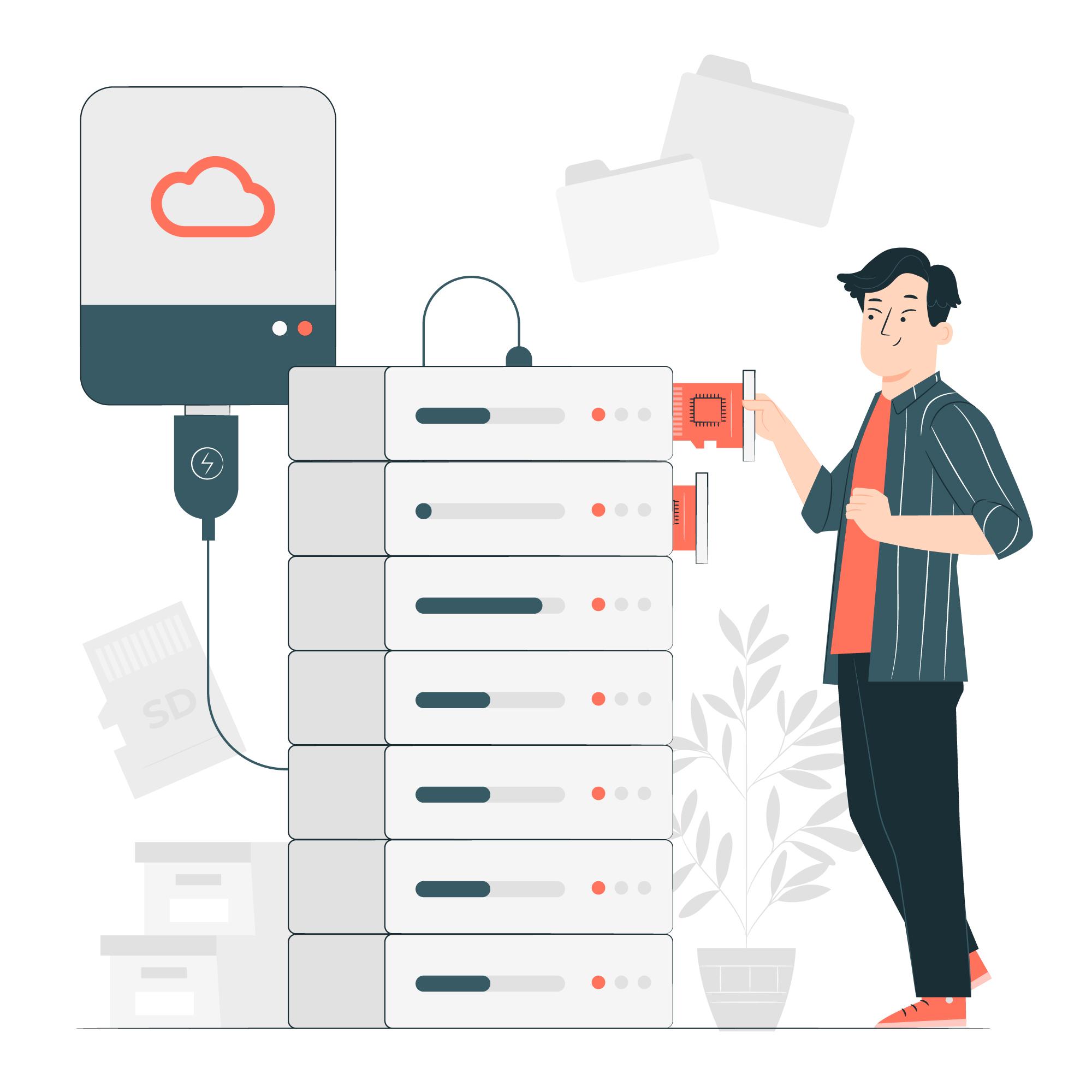
Comparing Different Server Hosting Options: Cloud vs. Dedicated vs. VPS
In the ever-evolving landscape of server hosting, businesses and individuals face the crucial decision of choosing the right hosting solution. With options like Cloud, Dedicated, and Virtual Private Servers (VPS) available, understanding the strengths and weaknesses of each is essential. Let's delve into the key characteristics of Cloud, Dedicated, and VPS hosting to help you make an informed decision. 1. Cloud Hosting: The Agile Solution Cloud hosting has gained immense popularity for its scalability, flexibility, and cost-effectiveness. In a cloud environment, resources are distributed across multiple virtual servers, offering redundancy and minimizing downtime. Here are some key points to consider: Scalability: Easily scale resources up or down based on demand, making it ideal for businesses with fluctuating workloads. Cost: Pay-as-you-go models allow users to pay only for the resources they consume, reducing overall costs. Reliability: With data stored across multiple servers, cloud hosting ensures high availability and minimizes the risk of hardware failures. 2. Dedicated Hosting: Unparalleled Performance Dedicated hosting provides exclusive use of an entire physical server, offering maximum performance and control. This option is favored by enterprises with specific requirements and steady workloads. Key features include: Performance: Dedicated servers provide dedicated resources, ensuring consistent performance even during peak times. Customization: Users have full control over server configurations, software installations, and security settings. Isolation: Enhanced security and privacy, as the server is not shared with other users. 3. VPS Hosting: A Balanced Approach Virtual Private Servers (VPS) strike a balance between the flexibility of cloud hosting and the performance of dedicated servers. In a VPS environment, a physical server is divided into multiple virtual machines with dedicated resources for each. Consider the following: Cost-Effective Performance: VPS hosting offers better performance than shared hosting, making it a cost-effective choice for businesses with moderate resource requirements. Scalability: While not as elastic as cloud hosting, VPS allows for scalability by upgrading resources without the need to migrate to a new server. Isolation: Each VPS operates independently, providing a degree of isolation and security. Choosing the Right Hosting Option: Factors to Consider Workload and Performance Requirements: Assess the nature of your applications and determine the level of performance required. Scalability Needs: Consider the scalability of your business and how well the hosting option can accommodate growth. Budget Constraints: Evaluate your budget and choose a hosting solution that aligns with your financial capabilities. Technical Expertise: Assess your team's technical expertise to manage and maintain the chosen hosting solution effectively. In conclusion, the choice between Cloud, Dedicated, and VPS hosting depends on the unique needs of your business or project. Each option has its merits, and understanding the specific requirements will guide you towards the most suitable hosting solution. Whether it's the agility of the cloud, the performance of dedicated hosting, or the balanced approach of VPS, making an informed decision is the key to a successful hosting experience.

A Step-by-Step Guide on How to Update PHP Version in XAMPP
XAMPP is a popular open-source software that provides a local development environment for web developers. It includes Apache, MySQL, PHP, and Perl, making it an all-in-one package for building and testing websites on your local machine. However, as technology evolves, it becomes essential to update the components of XAMPP to ensure compatibility with the latest web development tools and practices. In this article, we will focus on the process of updating the PHP version in XAMPP. Step 1: Backup Your Projects Before making any changes, it's crucial to create backups of your projects to avoid potential data loss. Copy your project folders to a safe location outside of the XAMPP directory. Step 2: Download the Desired PHP Version Visit the official PHP website (https://www.php.net/downloads.php) and choose the PHP version you want to install. Make sure to select the version compatible with your projects and any specific requirements. Step 3: Stop the XAMPP Apache Server To update PHP in XAMPP, you need to stop the Apache server. Open the XAMPP Control Panel and click the "Stop" button next to Apache. This will ensure a smooth update process without any conflicts. Step 4: Replace the Existing PHP Files Navigate to the XAMPP installation directory on your computer (usually located in C:\xampp). Inside the "xampp" folder, find the "php" subfolder. Rename the existing "php" folder to "php_old" or a similar name. Then, copy and paste the contents of the downloaded PHP version into the "xampp" directory. Step 5: Update Configuration Files Some changes may be required in the XAMPP configuration files to reflect the new PHP version. Open the "httpd-xampp.conf" file located in the "apache\conf\extra" folder. Update the PHP version in the following lines: ScriptAlias /php/ "C:/xampp/php/" Action application/x-httpd-php "/php/php-cgi.exe" Replace the paths with the correct location of your new PHP version. Step 6: Start the Apache Server After updating the PHP files and configuration, go back to the XAMPP Control Panel and click the "Start" button next to Apache. This will restart the Apache server with the new PHP version. Step 7: Test Your Projects Open your web browser and access your local projects to ensure they work correctly with the updated PHP version. Check for any errors or compatibility issues and make necessary adjustments if needed. Updating the PHP version in XAMPP is a straightforward process that ensures you can take advantage of the latest features and improvements in PHP for your local development environment. By following these steps, you can keep your XAMPP setup up-to-date and maintain compatibility with modern web development practices.

A Comprehensive Guide to Installing and Configuring Ubuntu Server
Ubuntu Server is a powerful, open-source operating system that is widely used for hosting websites, applications, and various server-based tasks. Installing and configuring Ubuntu Server may seem daunting at first, but with the right guidance, it becomes a straightforward process. In this article, we'll walk you through the step-by-step process of installing and configuring Ubuntu Server. 1. Preparing for Installation: Before you begin the installation process, ensure you have the following: A bootable USB drive or a CD/DVD with the Ubuntu Server ISO. A computer or server where you intend to install Ubuntu Server. A stable internet connection for updates and additional software installations. 2. Installation Process: Insert the bootable USB drive or CD/DVD into the server and power it on. Follow the on-screen instructions to start the installation process. Choose the language and region settings. Configure your keyboard layout. Select the installation option - "Install Ubuntu Server." 3. Disk Partitioning: Choose a disk to install Ubuntu Server. Select a partitioning method: Guided – use entire disk, Guided – use entire disk and set up LVM, or Manual. Confirm the changes to the disk. 4. System Configuration: Set up a user account, providing a username and password. Configure the clock and time zone settings. Choose whether to install OpenSSH for remote access (recommended for server environments). Wait for the installation process to complete. 5. Post-Installation Steps: Remove the installation media and press Enter to reboot the system. Log in using the credentials you set during the installation. 6. Basic System Updates: Before proceeding with any additional configurations, it's essential to update the system: sudo apt update sudo apt upgrade 7. Configuring Network Settings: Edit the netplan configuration file to set up networking: sudo nano /etc/netplan/01-netcfg.yaml Make the necessary changes, save, and apply them: sudo netplan apply 8. Installing Additional Software: Depending on your server's purpose, install necessary software. For example, to install a web server (Nginx): sudo apt install nginx 9. Firewall Configuration: Ubuntu Server comes with the Uncomplicated Firewall (UFW) tool. Enable it and allow necessary ports: sudo ufw enable sudo ufw allow 80 # Allow HTTP traffic sudo ufw allow 22 # Allow SSH traffic By following this guide, you've successfully installed and configured Ubuntu Server. Further customization and application installations can be done based on your specific server requirements. Keep the system updated and secure to ensure optimal performance and reliability. If you're using Nginx as your web server, here are the steps to enable PHP and PHPMyAdmin: Enabling PHP: Install PHP and the required modules: sudo apt install php-fpm Configure Nginx to use PHP: Edit the Nginx default server block configuration file: sudo nano /etc/nginx/sites-available/default Add the following lines inside the server block: location ~ \.php$ { include snippets/fastcgi-php.conf; fastcgi_pass unix:/var/run/php/php7.4-fpm.sock; # Adjust the version based on your PHP version fastcgi_param SCRIPT_FILENAME $document_root$fastcgi_script_name; include fastcgi_params; } Save the file and exit. Restart Nginx and PHP-FPM: sudo systemctl restart nginx sudo systemctl restart php7.4-fpm # Adjust the version based on your PHP version Verify PHP installation by creating a test file: echo "<?php phpinfo(); ?>" | sudo tee /var/www/html/phpinfo.php Visit http://your_server_ip/phpinfo.php in a web browser to see the PHP information page. Enabling PHPMyAdmin with Nginx: Install PHPMyAdmin: sudo apt install phpmyadmin During the installation, you'll be prompted to choose a web server. Do not select Apache; choose None. Create a symbolic link to the PHPMyAdmin configuration file in the Nginx configuration directory: sudo ln -s /etc/phpmyadmin/nginx.conf /etc/nginx/conf.d/phpmyadmin.conf Restart Nginx: sudo systemctl restart nginx Secure your PHPMyAdmin installation: sudo mysql In the MySQL shell, run the following commands: CREATE USER 'phpmyadmin'@'localhost' IDENTIFIED BY 'your_password'; GRANT ALL PRIVILEGES ON *.* TO 'phpmyadmin'@'localhost' WITH GRANT OPTION; FLUSH PRIVILEGES; EXIT; Replace 'your_password' with a strong password. Open a web browser and navigate to http://your_server_ip/phpmyadmin. Log in using the MySQL credentials you just created. With these steps, you should have PHP and PHPMyAdmin successfully installed and configured with Nginx on your Ubuntu Server. Adjustments might be needed based on specific server configurations or preferences.

Exploring Free Alternatives for cPanel: A Comprehensive Guide to Server Management
cPanel has long been a dominant force in the web hosting industry, providing a user-friendly interface and powerful tools for server management. However, for those seeking free alternatives due to budget constraints or a desire for open-source solutions, there are several capable options available. In this article, we'll delve into some of the best free cPanel alternatives that offer robust server management features without the associated costs. Webmin: Webmin is a versatile and open-source control panel that caters to Unix-like systems. It provides a clean and intuitive interface for server management tasks, including user account management, file handling, and system configuration. Webmin's modular design and extensive list of modules make it adaptable to a variety of server setups, making it a powerful alternative to cPanel. Virtualmin: Built on top of Webmin, Virtualmin is a free and open-source control panel designed specifically for managing virtual servers. It excels in handling multiple domains and offers features such as domain and user account management, DNS configuration, and email setup. Virtualmin is known for its scalability, making it suitable for both small-scale websites and larger, more complex hosting environments. ISPConfig: ISPConfig is an open-source control panel that serves both administrators and end-users. It provides a comprehensive set of features for server management, including website hosting, email configuration, and DNS management. ISPConfig's modular structure and plugin system enhance its flexibility, allowing users to customize their server environment according to their specific needs. CentOS Web Panel: Designed specifically for CentOS servers, CentOS Web Panel is a free and feature-rich control panel that simplifies server management. It offers tools for system monitoring, file management, and email configuration. CentOS Web Panel is known for its user-friendly interface and ease of installation, making it accessible to users with varying levels of technical expertise. Ajenti: Ajenti is an open-source control panel that focuses on simplicity and extensibility. It provides a clean and responsive interface for server management tasks, including system monitoring, file management, and user account administration. Ajenti's modular design allows users to add plugins for additional functionalities, offering a customizable experience for server administrators. CloudPanel: A noteworthy addition to the list is CloudPanel, a free and user-friendly control panel designed for cloud servers. CloudPanel simplifies server management, providing tools for domain and database management, SSL configuration, and more. Its focus on cloud compatibility makes it an excellent choice for those utilizing cloud-based hosting solutions. While cPanel remains a popular choice, these free alternatives offer compelling solutions for server management. Whether opting for the versatility of Webmin, virtual server capabilities of Virtualmin, comprehensive features of ISPConfig, CentOS-focused tools of CentOS Web Panel, the simplicity of Ajenti, or the cloud compatibility of CloudPanel, these alternatives cater to diverse needs without the financial burden. Explore these options to find the free cPanel alternative that aligns best with your server management requirements.